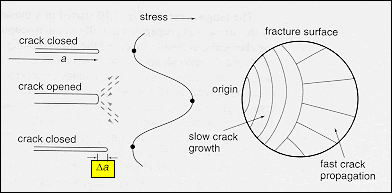| |
Typical
locations for stress concentration are shown in the top diagram. They serve
as locations at which cracks in the material can form and the process of fatigue
causes these cracks to grow during each stress cycle. This is illustrated
in the lower diagram.
In the compression part of the cycle, the applied
stress pushes the crack closed. In the tension part, the crack can extend
by an amount Da that is determined by the
nature of the material and the amplitude of the tensile stress. As long as a is less than a 'critical'
value, c,
the crack is stable and increases in length each cycle. Once the crack reaches
the 'critical' length, the material becomes unstable to fast fracture at
that stress and the sample fails. The critical crack length, c, is related to the surface energy
of the crack, g, Young's Modulus,
E, and the stress
at fracture, sCr ,by:
scr = (2 E g / pc)0.5 |
|
|
|
|
|
|
|
|
|
|
|
|
|
|

